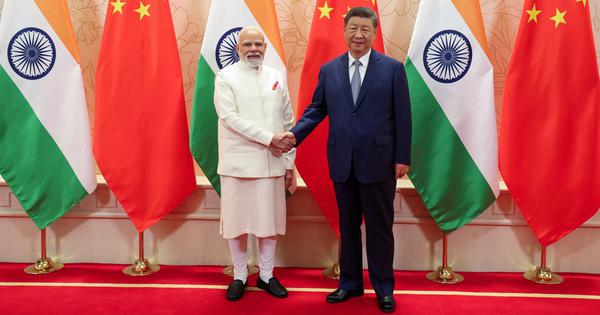
Days before Indian Prime Minister Narendra Modi reached Tianjin in China for the Shanghai Cooperation Organisation summit on August 31 and September 1, the Indian media was upbeat about Chinese Foreign Minister Wang Yi’s two-day Delhi visit from August 18.
A “reset” in China-India ties was expected, especially after the June 2020 Galwan clashes, commented one editorial. Another report claimed there was “consensus” on key points in a joint statement issued before Wang’s departure for Pakistan and Afghanistan.
However, India’s Ministry of External Affairs, while adopting a cautious approach, recognised that the Indian and Chinese representatives “spoke positively” even as the perception in New Delhi was that there was “peace and tranquility” in the India-China border areas.
While Wang’s Delhi visit was centred around the 24th round of special representative talks on the border, the Chinese leader’s sojourn was seen more as an attempt to lay the groundwork for the Shanghai Cooperation Organisation summit meeting between Modi and Chinese President Xi Jinping, which could form the basis for a deeper engagement to thwart US geoeconomic and geopolitical moves, especially in the wake of the 50% tariffs imposed on India by the Trump administration as a penalty for purchasing Russian oil.
Wang met three key actors from the Indian side – Modi, External Affairs minister S Jaishankar and National Security Adviser Ajit Doval. The consequent statement issued by the Indian Ministry of External Affairs reiterated New Delhi’s commitment to a “fair, reasonable and mutually acceptable resolution of the boundary question”.
On his part, Wang recognised after his meeting with the Indian national security advisor that “stability” had been “restored” on the border. He was willing to admit that the “setbacks” in the last few years were “not in our interest”. The two countries, Wang said, should be partners and not adversaries. While a decision to resume the religious and spiritual pilgrimage to Mount Kailash was arrived at in April, the two sides are keen to restart people-to-people contacts, recommence direct flights and reopen border trade.
This warming up of ties is being seen as a calibrated move to build a joint front to thwart what Chinese Ambassador to Delhi Xu Feihong called a “bully” – the US – and at a time when “tariff wars and trade wars are disrupting the global economic and trade system”.
Chinese Foreign Minister Wang Yi’s recent visit to New Delhi — his first in three years — is being hailed as a “breakthrough” that “could potentially reset” the trajectory of bilateral relations. https://t.co/O8vSEnJ6rP pic.twitter.com/RLMuIgsC1k
— The Diplomat (@Diplomat_APAC) August 27, 2025
The Pakistan factor
While Wang’s visit, Prime Minister Narendra Modi’s trip to Tianjin, and the Chinese ambassador’s strong characterisation of the US as a bully might appear that there is a thaw in ties that were strained only months ago, New Delhi would also be wary of the Chinese foreign minister’s onward visit to Pakistan where he met General Asim Munir.
Wang expressed China’s “steadfast support” for Pakistan’s sovereignty and development, which emboldened Islamabad to reaffirm the countries’ “all-weather strategic partnership”.
More importantly, Pakistan Prime Minister Shehbaz Sharif attended the formal launch of the second phase of the China-Pakistan Economic Corridor with both sides expected to “set clear priorities” aimed at agreeing on “tangible and measurable outcomes”.
For India, the CPEC-II is not only an expansion of Chinese power – a strategic lever under the Belt and Road Initiative – in Pakistan, it also “intensifies” security, territorial and geopolitical apprehensions. Besides, CPEC-II comes at a time when Islamabad is in the process of reengaging with Washington which will likely continue to give New Delhi a hard time now that it has announced that Sergio Gorokhovsky, a political appointee, will be Trump’s preferred choice as ambassador to India.
Closer ties between China and India make sense in the backdrop of Trump’s shock tariffs as both countries seek common ground. However, it is difficult to ignore India’s trade deficit with China, which stands around US$ 100 billion. There has been little effort from China to address Indian concerns and develop a more balanced trade relationship.
When China-India ties normalised in 1988 following then Prime Minister Rajiv Gandhi’s Beijing visit, both sides engaged proactively on trade and peace building. However, the failure of the confidence building mechanisms and the mounting trade deficit coupled with the 2020 Galwan clashes underscore the fragility and the inherent mistrust in this relationship.
China’s Xi Jinping hailed a new “far-reaching” partnership with India as the rival powers put a decades-long dispute behind them
Read more about the two countries’ fast-changing dynamics👇https://t.co/bXGopeFEeO pic.twitter.com/snnmS7QfXM
— The Telegraph (@Telegraph) August 31, 2025
Perception gap
The challenge is even as India tries to assert equal status, China’s perception is quite the opposite. This perception gap is exemplified by Beijing’s arguments over need for trade and people-to-people engagements, while New Delhi’s concern is centred around a proactive resolution of the thorny border issue.
Wang’s visit also raised challenges and questions on India’s shift in stance on the One China Policy as well as accepting the “early harvest boundary settlement” or resolving the boundary dispute in parts. The Indian stand over Taiwan where there has been a rise in Chinese aggression towards Taipei, and President Xi’s repeated pursuit of reunification, only helps Chinese narrative-building.
This curtails Indian efforts to build a complementary relationship with Taipei. The change in boundary settlement agenda underscores a win for Beijing, indicating that India needs China more than the other way round. This may be read as a sign of weakness.
In addition to recent Indian fears over the construction of a mega-hydropower project on the Yarlung Zangbo in Tibet, a railway line connecting Xinjiang to Tibet poses significant security concerns for New Delhi. China has continued to build and develop infrastructure across the Line of Actual Control with little regard for Indian concerns, whether ecological or conventional security. At the same time, China has regularly opposed Indian attempts to develop its own capabilities on its side of the disputed border, especially in Arunachal Pradesh.
Wang’s visit reflects China’s standard position that pitches its attitudes and policies towards India depending on where it stands in respect to the US. Beijing was aware that a second Trump presidency would pose significant geopolitical and geoeconomic challenges, which explains the growing warmth, since October 2024, with India.
The question is whether Chinese overtures are genuine and rooted in respect for India as an equal partner. A concrete shift in Beijing’s approach will minimise mistrust and help drive a fresh narrative. Otherwise, the recent parlays and the Tianjin summit will remain just political and diplomatic posturing.
Gunjan Singh is Associate Professor, Jindal Global Law School, O.P. Jindal Global University, Sonipat, Haryana.
Originally published under Creative Commons by 360info™.
This article first appeared on Scroll.in
📰 Crime Today News is proudly sponsored by DRYFRUIT & CO – A Brand by eFabby Global LLC
Design & Developed by Yes Mom Hosting






